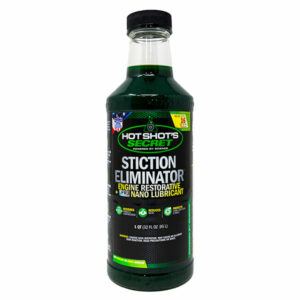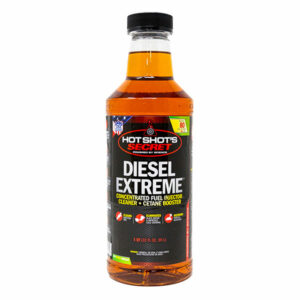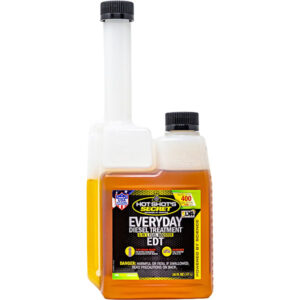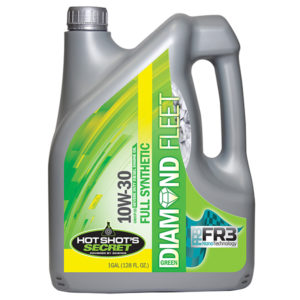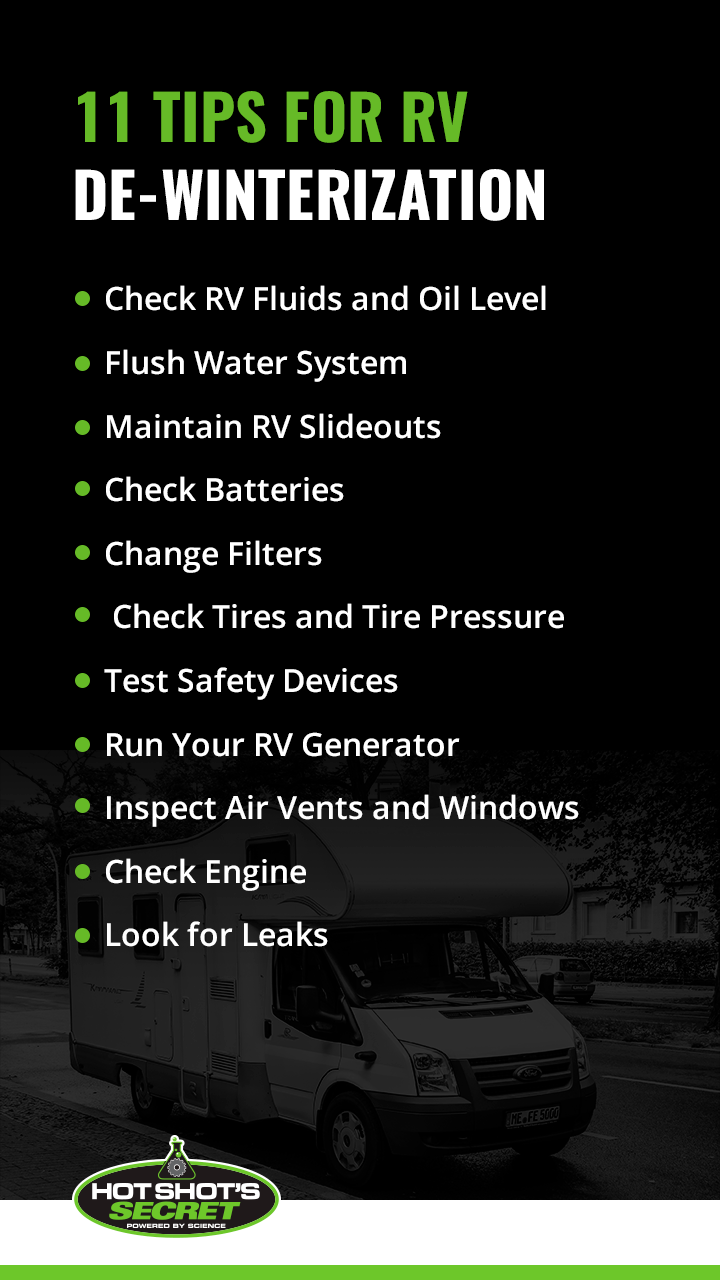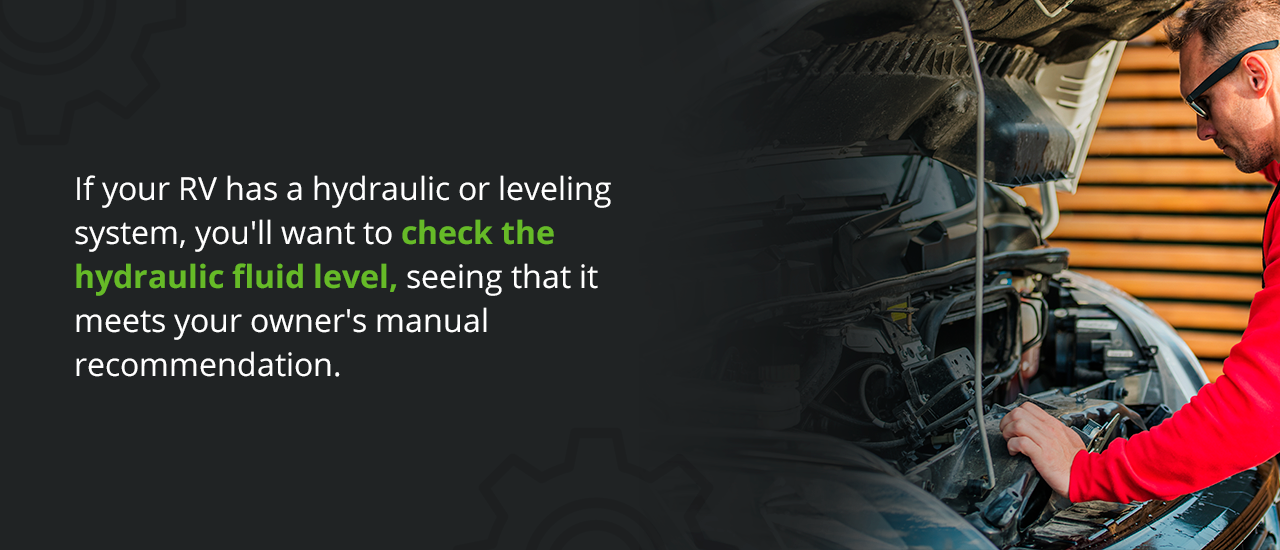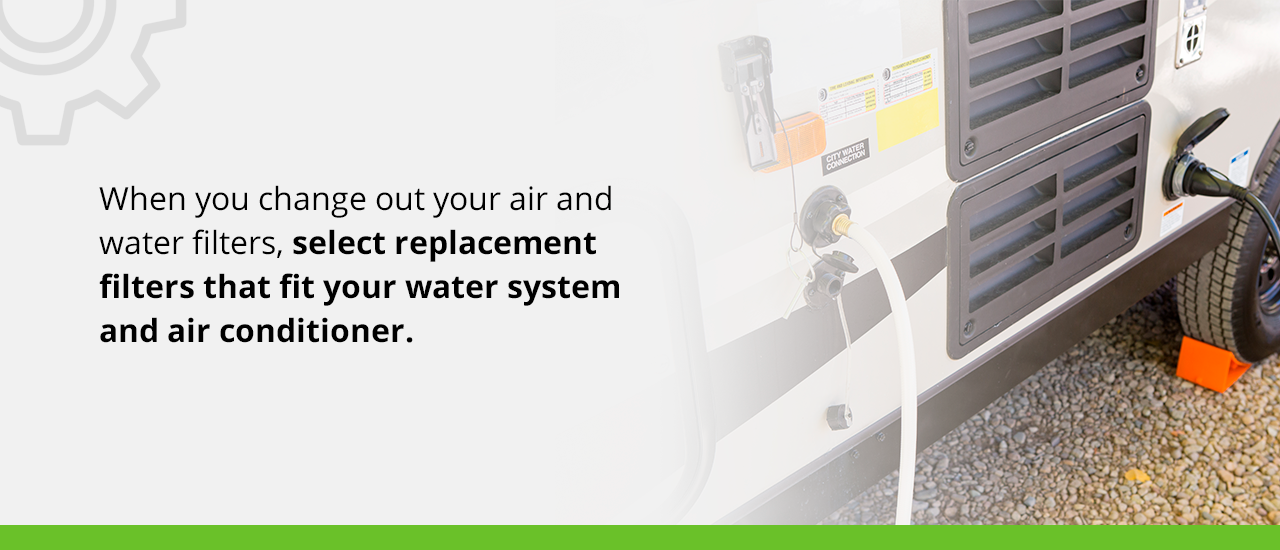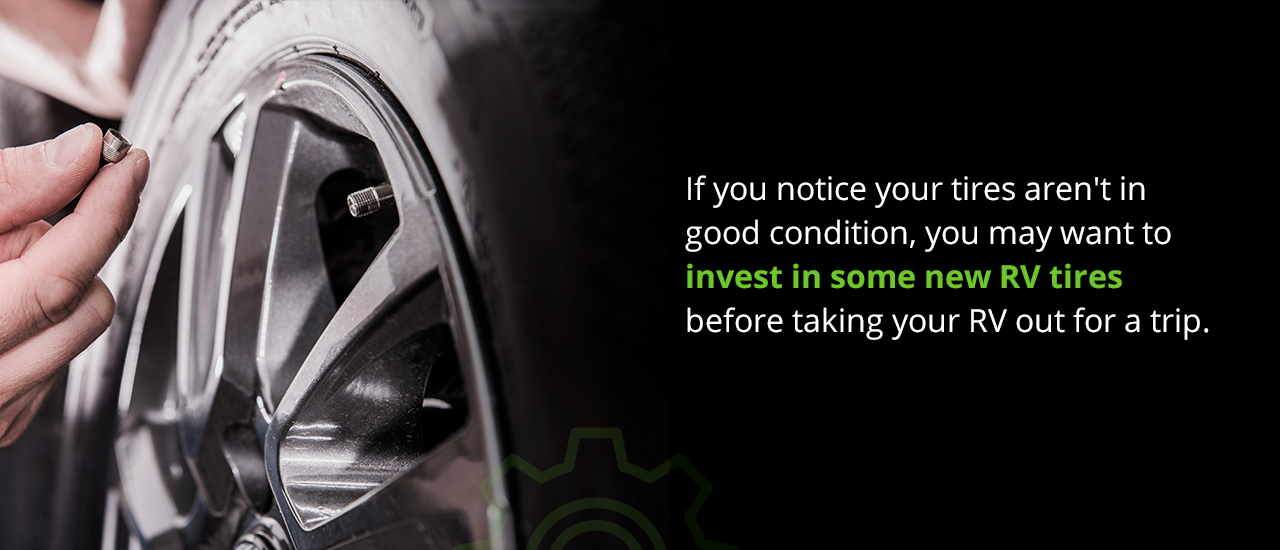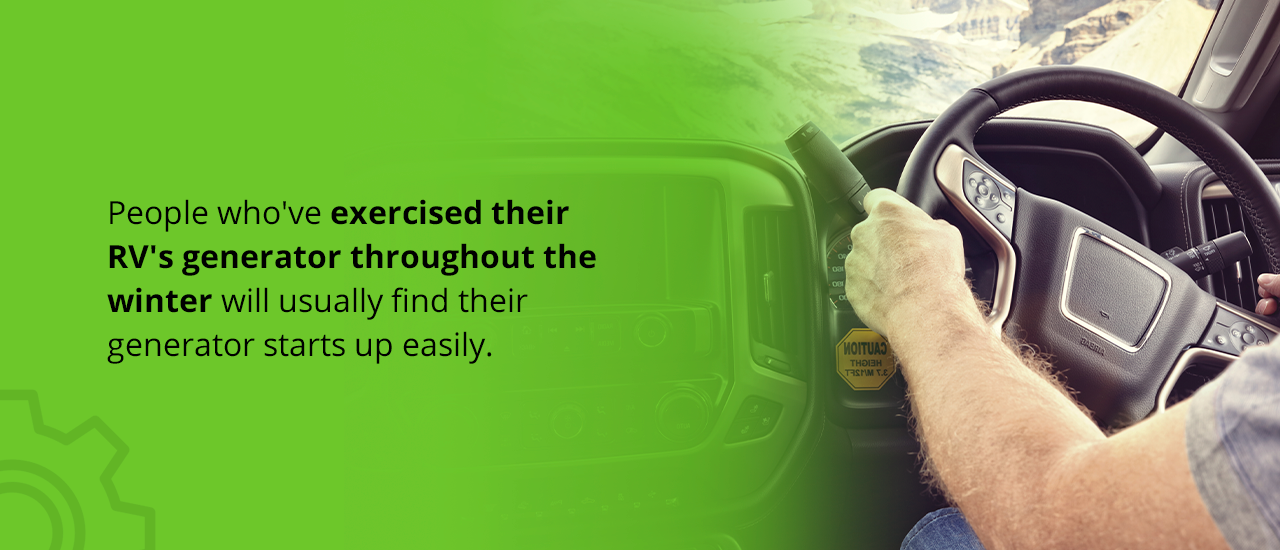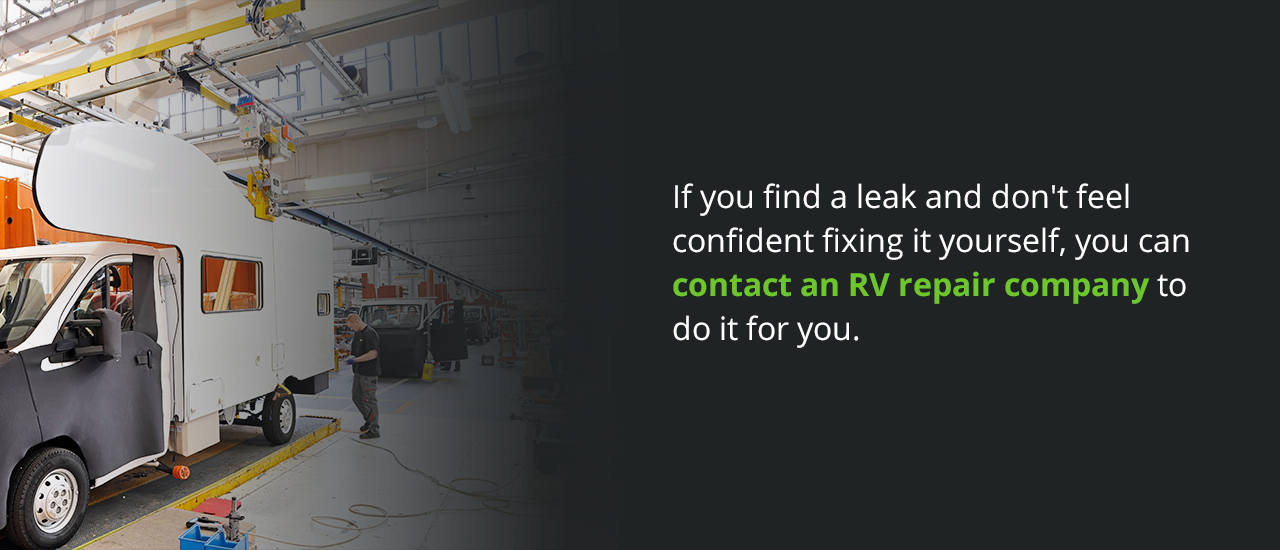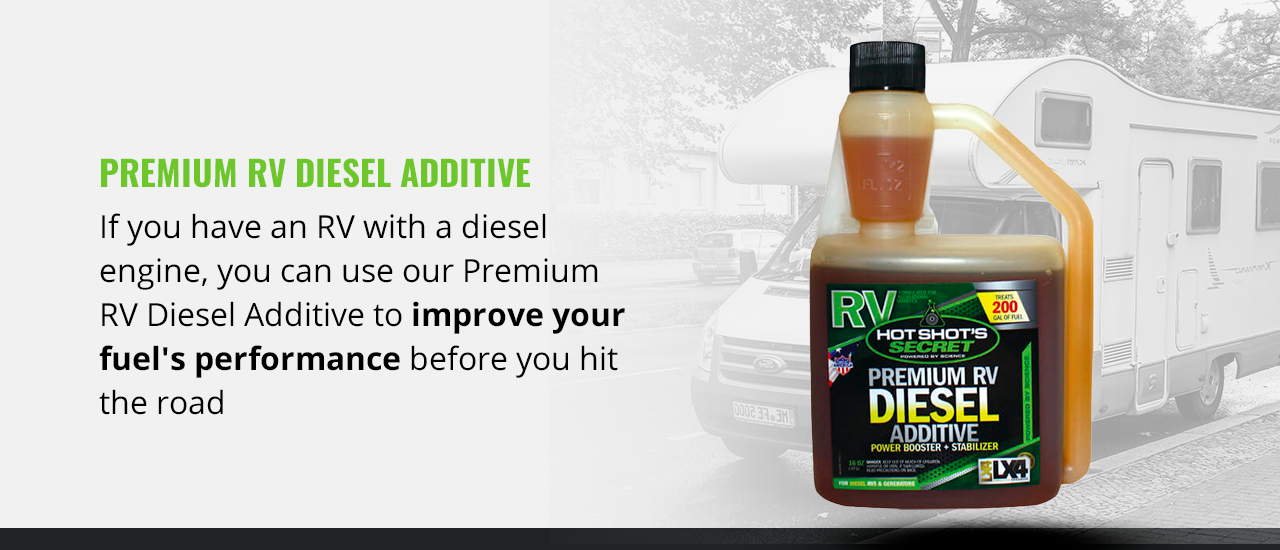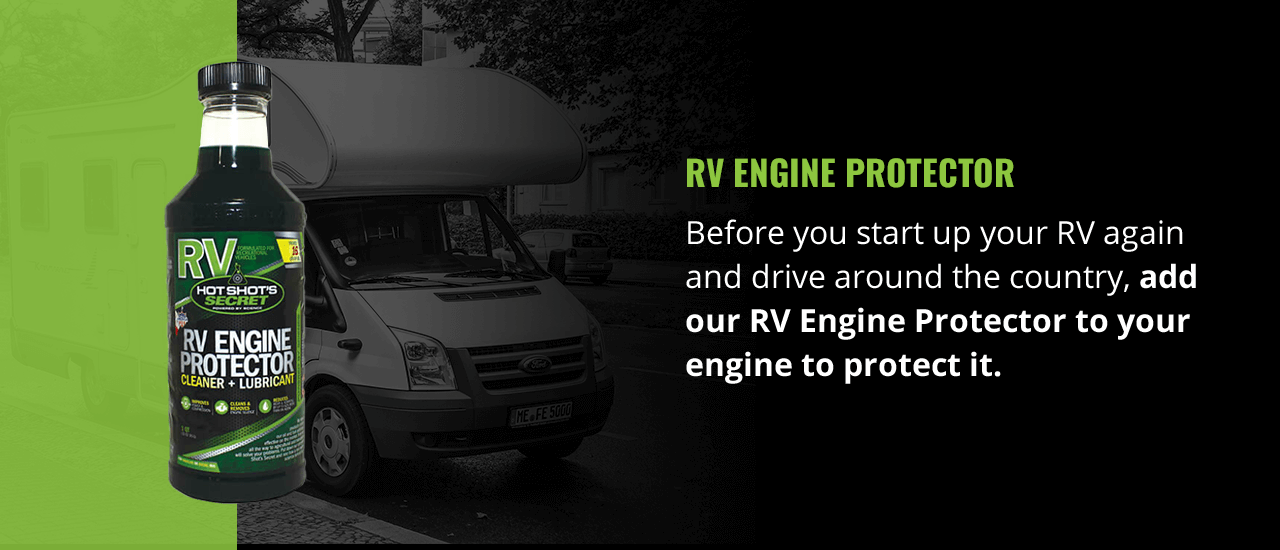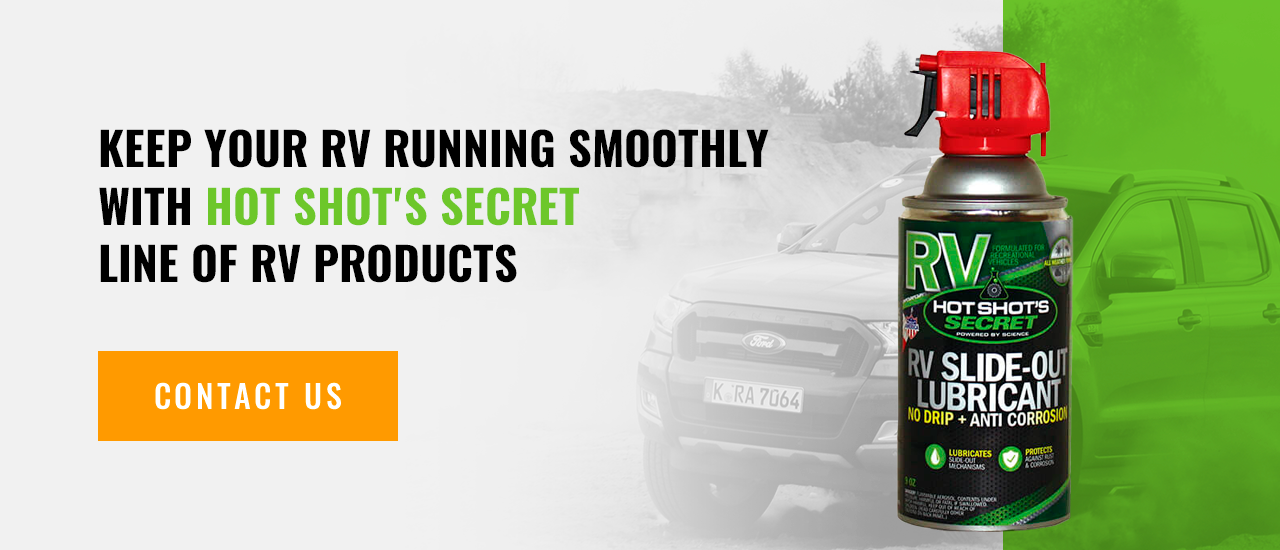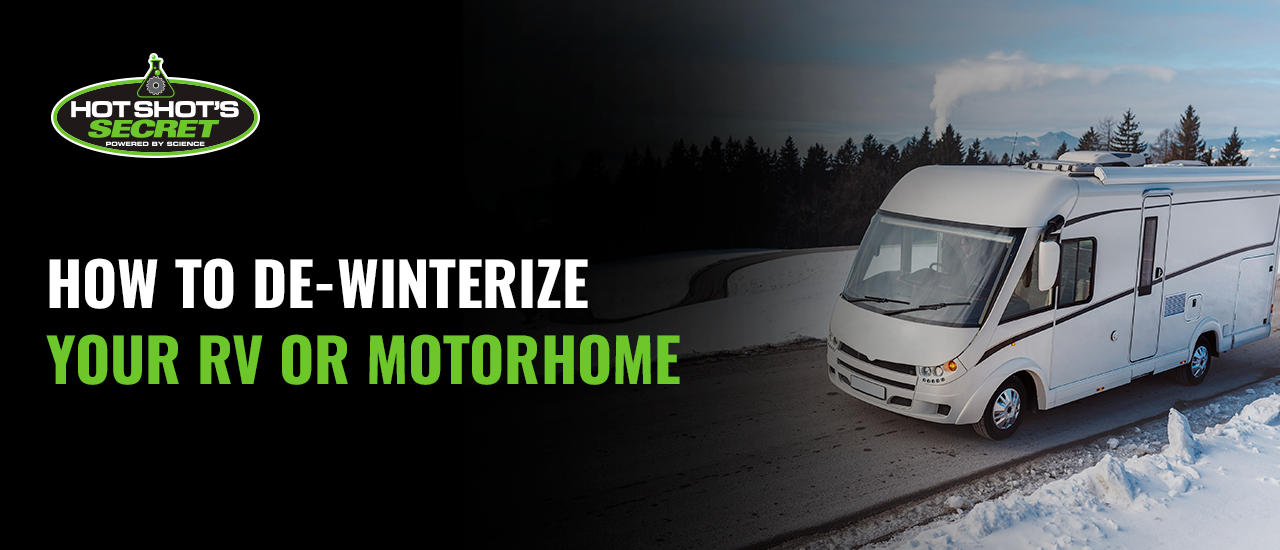
When you’re planning to hit the road with your RV or motorhome after a long winter, you’ll first want to de-winterize it. This process helps you prepare your RV for warm spring and summer days, ensuring it can perform at its best. Learning how to correctly de-winterize your motorhome can help you prevent potential issues and have the best experience possible when you set out on a trip.
Find out more about why you should de-winterize your RV and the 11 steps you can take to prepare your RV for camping season. Plus, you can learn about the products we offer at Hot Shot’s Secret and how they can help your motorhome run more efficiently and perform better. Together, this information will ensure you have a fantastic spring and summer on the road with your RV.
Why You Should De-Winterize Your RV or Motorhome
If you’ve left your RV in storage for the winter, it’s best practice to de-winterize it before you take it out on the road. When fall and winter arrive, RV owners will winterize their vehicles so they remain protected throughout the cold winter months. Since winterization often involves adding antifreeze to the motorhome’s water and making other changes to protect it during the winter, an RV isn’t always immediately ready for use when spring arrives.
Alongside the effects of any winterization actions you took, months of cold weather and lack of use can also negatively impact key RV components, causing deflated tires and drained batteries. As a result, if you don’t de-winterize your RV, you’ll be putting yourself at greater risk of accidents and other safety issues.
Due to all these factors, de-winterization is necessary if you want your RV to function appropriately and keep you safe. Ensure the upcoming camping season is as comfortable as possible by de-winterizing your motorhome this spring.
11 Tips for RV De-Winterization
Before camping season starts, you can take a few steps to de-winterize your RV and ensure it performs at peak condition once you take it on the road. Some of the primary RV spring maintenance actions you’ll want to perform to de-winterize your RV include checking the oil level, flushing the water system, replacing filters and inspecting the tires. By ensuring your RV is fully ready to go, you can feel confident your RV is in the best condition possible when you hit the open road.
Get your RV ready for the spring and summer by following these 11 tips for RV de-winterization.
1. Check RV Fluids and Oil Level
Your RV runs on various fluids, such as windshield and brake fluid and engine, power steering and transmission oil. Before you fire up your RV and take it on a trip, you’ll first want to check the level of these oils and fluids. Usually, your owner’s manual will have information about the right levels for your RV. Check your oil and fluid levels against the manual’s specifications to ensure your RV will run properly.
If you notice your fluid and oil levels are lower than specified, you’ll likely want to refill them to the appropriate amounts. You can also clean out your engine oil by using our RV Engine Protector. In addition to the product’s ability to clean any burnt engine oil, it utilizes a patented nanocarbon for extra wear protection.
Before you take your camper out of storage, you should also ensure your coolant is at the appropriate levels. If your coolant’s at a low level, you’ll want to refill it. Choose one of our premium pre-diluted RV Antifreeze/Coolant options to give your motorhome the best replacement coolant possible.
2. Flush Water System
One of the biggest steps you can take to de-winterize your RV is to flush your water system. When you first winterized your RV, you probably added antifreeze to its water system to stop the pipes from freezing. Since you don’t want antifreeze in your water, you’ll want to flush your water system.
To flush your water system, turn your water pump on and run the water for a few minutes with all showers, sinks and faucets on. You’ll then want to flush the toilet while the pump runs. Once the water starts to come out clear, you’ll turn off the pump and close your faucets. Finally, replace your water filter cartridges and take your water heater off bypass mode.
3. Maintain RV Slideouts
Another crucial part of RV maintenance is preparing the slideouts for the spring. To begin, ensure these slideouts can fully open and close, sealing fully in the closed and open positions. Next, you’ll want to see if the leveling jacks or systems retract completely and can adjust to a support position without any difficulty.
If your RV has a hydraulic or leveling system, you’ll want to check the hydraulic fluid level, seeing that it meets your owner’s manual recommendation.
When you check the fluid level, you’ll want to retract all of the slideouts and jacks. For RVs with awnings, you can check if they close and open fully. Additionally, you may want to see if the awning’s fabric is in good condition.
Before you take the RV out of hibernation, you can also use a lubricant on the slideouts to ensure they operate smoothly and quietly. Our RV Slide-Out Lubricant protects slideout mechanisms against corrosion and rust. All you have to do to use the lubricant is pull out the slideouts and spray their gears and tracks.
4. Check Batteries
During the winter, your RV batteries will likely lose part of their charge from internal leakage. Unless you regularly checked and recharged your batteries while your RV was in storage, they’ll lose a percentage of their charge for every month they sat unused. Due to this power loss, you’ll want to use a voltmeter to check your batteries’ charger. If you want an accurate reading, ensure your RV isn’t connected to electricity. Compare the reading to your battery’s recommended reading.
If your batteries are below a recommended reading, you’ll want to charge them. To do so, turn off your battery first and then connect the RV charger to the battery charger. After you attach the chargers, turn the battery charger on and let it run until the battery charges all the way. The charging process may only take a few hours, but it could also take a few days, depending on your battery size.
Alongside charging your batteries, you’ll likely also want to check the battery water level, adding distilled water if the water isn’t at the right level. Take note that if you see the water is under the plates, you should add water prior to charging the battery. If you had uninstalled your batteries for winter storage, reinstall them and ensure they’re properly connected.
5. Change Filters
As you de-winterize your vehicle, you’ll want to pay attention to your filters. Start with your air filters, as they may have debris and dust trapped in them from the prior camping season. It’s also smart to swap out your water filters to ensure you have clean water.
When you change out your air and water filters, select replacement filters that fit your water system and air conditioner. These filters should fit securely, so they can filter out bacteria and dirt properly.
Besides being able to have clean air and water, adding new filters to your water systems and air conditioner can help you save energy and ensure these systems work more efficiently.
Alongside changing your air and water filters, you can also swap out your fuel filters for new ones. If you start your RV traveling season with a clogged filter, you could end up stranded on your way to a campsite. Like air and water filters, ensure any replacement filters fit. While you’re changing your filter, you can also add our Premium RV Diesel Additive and Premium RV Gas Additive products to your fuel system to improve your fuel mileage and quality.
6. Check Tires and Tire Pressure
When your RV sits in storage for the winter, its tires will lose around two to three pounds-per-square-inch of air pressure per month. If you have your RV stored in a cold area or outdoors, you may see even more air pressure loss. Since deflated tires can cause uneven wear, poor handling and blowouts, you should check your tire pressure before taking your RV out on the road.
You can check your RV’s air pressure by using a tire pressure gauge. If you notice the tires aren’t at an air pressure in line with your owner’s manual recommendation, reinflate them to meet the listed number. Besides checking tire pressure, you can also inspect your tires for signs of wear, such as worn-down treads and sidewall cracks. If you notice your tires aren’t in good condition, you may want to invest in some new RV tires before taking your RV out for a trip.
7. Test Safety Devices
When you take your RV out of storage, check to see whether your safety devices work as intended. Your RV should have a carbon monoxide detector, smoke alarm, LP detector and fire extinguisher. Start by replacing the batteries in your battery-powered devices with new ones. Next, test the smoke alarm and carbon monoxide detector to ensure they’ll pick up on dangerous fumes.
Once you’ve ensured these devices work and have new batteries, move on to your fire extinguisher, reviewing its expiration date to see if it needs replacing. If you have a dry powder fire extinguisher, some of its powder may have settled at the bottom. Shake the fire extinguisher and tap its base to ensure the powder is evenly distributed.
8. Run Your RV Generator
Another essential de-winterization step is to run your RV generator and test it. Before you turn the generator on, ensure there isn’t any exhaust system damage. If you run the generator with exhaust system damage, you can end up harming your generator. Additionally, you’ll want to check the generator’s oil level, having a professional service it if the oil level is low.
Once you’ve verified the exhaust system is in working order and the oil is at optimal levels, turn on your generator and test it. People who’ve exercised their RV’s generator throughout the winter will usually find their generator starts up easily.
However, if you didn’t run it during storage, you’ll want to let it run at a half-rated load for a few hours to verify it works. When you can’t get the generator to start or it surges, you should hire a professional to inspect and repair it.
9. Inspect Air Vents and Windows
You probably want fresh air circulating throughout your RV once you take it camping, so you should inspect your window and air vents. To begin, ensure your windows can open fully. If they do, leave your windows open for a little while to let out the stuffy air that accumulated during storage.
Once you’ve verified the windows open, inspect the air vents to ensure they allow air into your camper. These vents help circulate fresh air throughout your RV to keep the camper cool and prevent excess humidity. Additionally, air vents prevent toxic gas from building up in your RV once you switch on the heater during the fall, so their proper functioning is essential to your safety. Inspect them to ensure they’re not clogged and allow air throughout the RV.
10. Check Engine
Another way you can de-winterize your RV is to check the engine. Begin by ensuring the lights and controls work. You can also inspect the engine for any signs of damage, and if you spot any, you should have a mechanic inspect it and make any repairs. While you’re checking the engine, you may also want to examine the fluid levels discussed previously and add any relevant RV additives.
Once you’ve inspected the engine and verified everything appears to be in working order, you can start the RV. When it turns on, verify the windshield wipers, taillights, headlights and dash lights are operational. If you see any service lights flash on, you’ll want to have the engine inspected by a professional.
11. Look for Leaks
One of the last things you can do to prepare your vehicle for the spring is to check for any leaky pipes in your plumbing system. After verifying that your freshwater tank contains water, look for signs of leakage by starting your electric pump. With the pump on, let it pressurize your RV’s water system, waiting until the pump automatically shuts off when it fully pressurizes the system.
If your pump doesn’t turn off or begins the pressurization process again, your water system probably has a leak. Since it may take a little while for the pump to turn itself back on, wait a few minutes and listen closely to see if it starts back up.
When the pump indicates signs of leakage, start by looking under the sink and at the pipe system for leaks. You can also look around the edges of the toilet to see if it’s leaking. You’ll want to address leaks as soon as possible since excess water harms your motorhome by creating mold, stains and more. If you find a leak and don’t feel confident fixing it yourself, you can contact an RV repair company to do it for you.
Use RV Maintenance Products From Hot Shot’s Secret
While we touched on some of our top RV products at Hot Shot’s Secret earlier, you may want to know more about how they can help your RV run at peak efficiency. Since you’ll already be working on your RV during the de-winterization process, it’s the perfect time to utilize our RV maintenance products. Many RV owners love adding them to their camper since they provide several benefits, such as improving your fuel or engine’s performance and keeping important parts clean.
Find out more about how these products can benefit your RV below.
1. Premium RV Diesel Additive
If you have an RV with a diesel engine, you can use our Premium RV Diesel Additive to improve your fuel’s performance before you hit the road.
Since this additive improves your diesel’s cetane rating, it provides your engine with better fuel economy and gives it more power. These additives also increase your fuel’s lubrication, promoting greater reliability and longevity. Plus, they improve your fuel’s stability to assist with extended storage and prevent varnish and gum from building up in your fuel system.
2. Premium RV Gas Additive
Like our diesel additive, we’ve designed our Premium RV Gas Additive to improve a gas-powered engine’s fuel. When you add this fuel additive to your RV, you can expect it to clean your fuel injectors for better performance. These products also clean the whole fuel system, removing deposits from the intake valve and combustion chamber. As a result of this cleaning, you’ll receive greater power and fuel economy. Finally, these additives stabilize your gas and lubricate it to assist with safer extended storage.
3. RV Engine Protector
Before you start up your RV again and drive around the country, add our RV Engine Protector to your engine to protect it.
We’ve formulated this premium RV oil additive to increase your engine’s reliability and performance. When you add it to your engine, it’ll clean out harmful varnish, debris and stiction. The product also features our patented FR3 Nano Lubricant, which significantly reduces engine friction and lowers wear by 62%. You can use this product in any gasoline or diesel engine.
4. RV Slide-Out Lubricant
When you’re de-winterizing, treat your RV by using our RV Slide-Out Lubricant on its slideouts. We’ve specially formulated this product to prevent common dangers, like corrosion and rust, from forming on key components. This RV spray lubricant also extends the lifespan of your slideouts, and you can safely use them on vinyl, rubber, plastic and metal. Many RV owners love how the product ensures their slideouts operate quietly and smoothly.
5. RV Trans Protector
After taking your RV out of storage, be proactive in protecting your RV maintenance by using our RV Trans Protector. We’ve specially formulated this product to combat common transmission issues, such as rough operation, burning fluid and poor or inconsistent shift quality. As a transmission additive, the product cleans out any debris and varnish from the transmission, helping your RV run quieter and improve shift quality. The RV Trans Friction also reduces friction, decreasing potentially damaging high operating temperatures as a result.
Keep Your RV Running Smoothly With Hot Shot’s Secret’s Line of RV Products
With all of the high-quality products we offer at Hot Shot’s Secret, you have endless to choose from to help your RV run as smoothly as possible. Everything goes through a rigorous three-step testing process to ensure they comprehensively address the issues they’re set out to solve. Alongside our highly effective products, we’re dedicated to providing exceptional customer service. We offer an industry-leading money-back guarantee.
Browse our selection of RV maintenance products before you break out your RV for the spring and summer. If you have any questions, please don’t hesitate to contact us.

